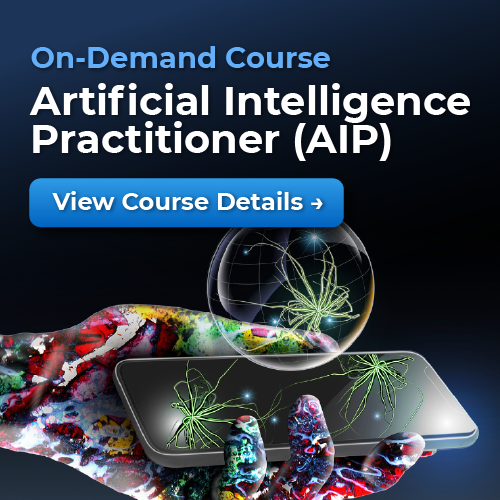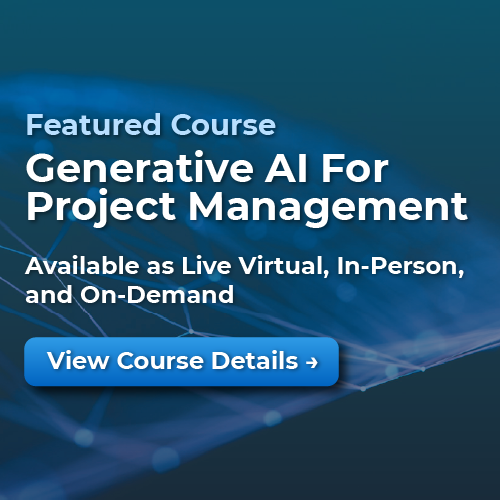By Harold Kerzner, Ph.D.
April 5, 2023
Introduction
During the past several years, we have seen dramatic improvements in artificial intelligence (AI). The potential benefits that companies envision resulting from the continuation of AI research is significant. Some of the benefits include image and speech recognition, report preparation, medical advances, better products and services, and robotics. All new AI inventions or technical breakthroughs will have both advantages and disadvantages. Most people believe that the advantages or using AI greatly outweigh the disadvantages.
The world-wide project management community of practices is slowly recognizing how AI will be able to improve the practice of project management. Some of the expected project management benefits from AI include:
- Elimination of mundane tasks or repetitive jobs
- Elimination of human errors
- More risk mitigation options
- 24/7 availability
- Improvements in project staffing
- Unbiased decision-making
- Reduction in the time needed for decision-making
- Elimination of emotions in decision-making
- More information available for project decision-making
- Better understanding of the root causes of some problems
- Lowering of project costs
- Better tracking of assumptions, constraints, and trends
- Better use of “what if” scenarios
- Better tracking of VUCA (Volatility, uncertainty, complexity, and ambiguity) issues and the enterprise environmental factors
- Ability to make strategic rather than just operational decisions
- Ability to make long-term rather than just short-term decisions
Although the rewards from successful AI implementation appear to be well worth the effort, there are challenges that must be considered first because some of the risks could result in significant damage or disruption to an organization. Some of the risks facing project management organizations are presented in the sections that follow.
Costly Implementation
One of the biggest challenges facing organizations in the implementation of AI will be the implementation cost. Experts in AI estimate that the implementation cost in some organizations could conceivably be in the millions of dollars. Some companies may believe that it is too costly to develop their own AI software and prefer to purchase a third-party package.
A top concern for senior management that purchase AI packages then becomes how to protect themselves from outsiders that may find ways to tamper with the firm’s systems and extract proprietary information. Before purchasing a third-party package, the organization must have a good understanding of the safety protocols in purchased packages and what can be done to prevent misuse and external tampering. There is also the concern for how continuous improvement efforts will be made to purchased packages due to degradation. The protection for company proprietary data is critical.

In the future, it seems more likely that organizations will develop their own AI systems. Universities are offering degrees in AI and there are professional societies and companies offering certification programs in AI. Each year, more and more people are developing skills in AI applications, and this may encourage organizations to hire these people and develop their own AI programs specifically customized for project management applications. However, there can still exist employee misuse.
Policies and Procedures
Senior management must consider what AI policies and procedures need to be put in place, regardless of whether the AI software is purchased or developed internally. This includes who is allowed to use the AI system, how partners and stakeholders will be allowed to interact with AI, who will be responsible for compliance with government regulations and laws on the use of AI, and how continuous improvements will be managed. Project management policies and procedures must also exist enforcing workers to use AI in an ethical manner.

The responsibility for policies and procedures may be delegated to a project management office (PMO). As AI grows, companies may recognize the need for an AI PMO dedicated to project and program applications, and with the additional responsibility of establishing and enforcing AI project management policies and procedures.
Some organizations may require that each project team have at least one person that may be certified in project management AI applications and with skills that include statistical methods, computational intelligence, and optimization techniques. This person may also be responsible for answering any client’s questions as to the source of the information from which a decision is made.
Legal Responsibility
The policies and procedures that companies develop will at least initially be based upon legal factors. Companies would like to see legislation for the right to data privacy on certain information. Information stored in AI systems may be company proprietary data on project performance or personal information that some people would not like to have shared by AI.
Another serious issue that the legal profession is currently considering involves who should be held accountable if something goes wrong because of the use of AI in making some project decisions? Should blame be placed upon the programmers or company that created the AI tool? Or should blame be placed upon the company using the tool? Or should the fault rest with the worker or operator that followed the instructions from AI? Who should be blamed if someone is physically hurt because of using AI information? The answers to these questions will become the foundation for many of the project management AI policies and procedures.

The legal profession is now working on guidelines and possible laws related specifically addressing the use of AI. The results from these laws could significantly impact contract negotiation between stakeholders, clients and contractors when embarking on new types of projects that may use AI. AI legislation can be expected to impact how project teams might try to mitigate certain types of project risks.
Stakeholder Buy-In
Another serious challenge, with possible long-term cost implications, is how stakeholders might react to the use of AI systems on their projects. Assessing clients for use of AI as part of project monitoring, control, and status reporting may seem practical. The cost of AI could be billed on a project-by-project basis or included in the overhead structure of the firm. However, not all clients may want or agree to having AI make decisions on their projects and may be reluctant to pay for AI support.
It may appear that the solution is to ask clients during contract negotiations about the use of AI on their projects, but that would require organizations to be willing to support multiple project management methodologies, some of which will not use AI. Team members that become accustomed to depending upon AI for certain activities may be reluctant to do their job without using AI. Companies will be challenged on whether AI applications on projects can be piecemeal.

Need for Continuous Improvement
AI systems are subject to degradation and the software can become outdated. System support will be needed on a continuous basis. New Information must be continuously added into the system and outdated material should be removed.
There are two types of support needed for project management AI systems: technical support and project management continuous improvement knowledge extracted from the capturing of project best practices. There may be a separate functional unit, perhaps as part of the IT organization, responsible for technical support. However, including new project management information may be the responsibility of AI PMOs that continuously debrief project teams to capture best practices. The AI PMO may have the added responsibility to ensure that the output of information from AI remains accurate and to audit project teams to ensure that they are using AI in an ethical manner.

AI Data Bias
There exists a belief that, since AI is part of a computer system, it is unbiased. This is certainly not true. Data bias occurs when the data included in the knowledge repository that supports AI is incomplete or skewed. The bias may be intentional or unintentional. Data bias can be skewed when people make assumptions about what information to include in the AI system or withhold critical information. When updating the information in an AI system, team members may be reluctant to provide accurate information that can be traced back to mistakes that they made or work that they performed incorrectly.

Data bias can result in highly optimistic projections of how long a certain activity should take or how much it should cost. Workers might intentionally skew the data or provide false data if they believe that the growth in AI capabilities may result in loss of employment.
Human Interactivity
Human interactivity deals with the way that workers will interact with the information provided by AI. Workers may be told to perform work differently than they are accustomed to. Workers may be told to act in a manner that subjects them to possible physical harm.
Non-physical harm should also be considered. This could result from AI providing erroneous information or when workers intentionally disregard AI and use their own information. As an example, workers may provide incorrect project cost information in status reporting that could result in stakeholders making the wrong decisions resulting in a change in the direction of the project.

Another fear that companies are considering is when AI’s capabilities expand to a point where it makes people feel lazy and eliminates their opportunities to be creative and provide meaningful ideas or solutions to problems. Workers have needs and expectations when assigned to projects. AI must be aligned to the human needs and goals, and this will require careful programming.
Loss of Employment
Human interactivity includes how workers believe that AI will impact their career goals. Workers may intentionally avoid using AI or following AI’s instructions if they believe that they may lose their jobs as AI begins taking over certain mundane tasks. Workers may become significantly disgruntled, exhibit destructive behavior tendencies, and even try to sabotage the AI system or cause it to generate misleading or incorrect information.

Lack of Emotions and Creativity
There are applications for AI on almost all projects. However, perhaps the greatest weakness is that AI lacks the ability to introduce creativity into many project decisions. This may change in the future. AI may be able to provide some creativity input into implementation of an existing solution but may not be able to create totally new or innovative solutions. The need for active participation by people for creativity requirements will still exist.

Conclusions
After reading all the risks identified in this article, you should ask yourself, “Is AI worth consideration for project management applications?” The rewards resulting from AI applications in project management certainly exceed the risks. The world appears enamored and highly interested in AI applications. We cannot predict at present the impact that AI will have on project management, but the current belief is that AI has massive potential advantages in both the short-term and the long-term. But as mentioned throughout this article, plans must be made to overcome the challenges.

About the Author
He has authored or co-authored more than 60 textbooks/workbooks on project management, including multiple editions of his seminal works. His books include Project Management: A Systems Approach to Planning, Scheduling and Controlling; Project Management Metrics, KPIs and Dashboards; Project Management Case Studies; Project Management Best Practices: Achieving Global Excellence; The Future of Project Management; Using the Project Management Maturity Model; and Innovation Project Management.
Dr. Kerzner holds an MS and Ph.D. in Aeronautical and Astronautical Engineering from the University of Illinois and an MBA from Utah State University. He taught engineering at the University of Illinois and business administration at Utah State University, and for 38 years taught project management at Baldwin-Wallace University. A testament to Dr. Kerzner’s profound influence on the field is the establishment of the Kerzner International Project Manager of the Year Award. This prestigious award, presented annually by the Project Management Institute (PMI) which recognizes outstanding project managers who have demonstrated exceptional leadership, innovation, and contributions to the project management profession.
Disclaimer: The ideas, views, and opinions expressed in this article are those of the author and do not necessarily reflect the views of International Institute for Learning or any entities they represent.






